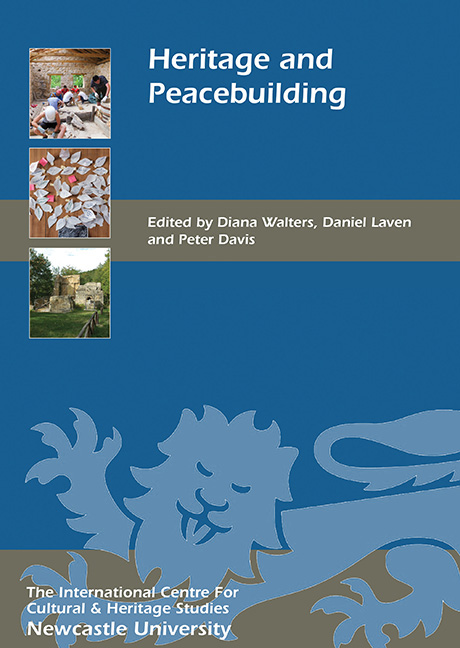Book contents
- Frontmatter
- Contents
- List of illustrations
- Acknowledgements
- List of abbreviations
- Preface
- Introduction
- NEW AND EMERGING IDEAS AROUND HERITAGE AND PEACE
- HERITAGE AND PEACEBUILDING IN PRACTICE
- HERITAGE, PEACEBUILDING AND SITES
- 14 A Conversation with Yongtanit Pimonsathean: Managing Conflict in Thailand
- 15 Challenging the Roots of Prejudice: the Monte Sole Case Study
- 16 Mau Mau: the Divisive Heritage of Liberation Struggle in Kenya
- 17 The Heritage of Geopolitical Borders as Peace Tourism Attractions
- 18 Rebuilding the Broken: Regional Restoration Camps as a Meeting Platform in the Western Balkans
- 19 Conflict or Reconciliation? Industrial Heritage Practices at a Turning Point
- 20 A Conversation with Saleem Ali: Environmental Challenges and Conflict Resolution
- List of Contributors
- Index
- Previous Titles
14 - A Conversation with Yongtanit Pimonsathean: Managing Conflict in Thailand
from HERITAGE, PEACEBUILDING AND SITES
Published online by Cambridge University Press: 16 February 2018
- Frontmatter
- Contents
- List of illustrations
- Acknowledgements
- List of abbreviations
- Preface
- Introduction
- NEW AND EMERGING IDEAS AROUND HERITAGE AND PEACE
- HERITAGE AND PEACEBUILDING IN PRACTICE
- HERITAGE, PEACEBUILDING AND SITES
- 14 A Conversation with Yongtanit Pimonsathean: Managing Conflict in Thailand
- 15 Challenging the Roots of Prejudice: the Monte Sole Case Study
- 16 Mau Mau: the Divisive Heritage of Liberation Struggle in Kenya
- 17 The Heritage of Geopolitical Borders as Peace Tourism Attractions
- 18 Rebuilding the Broken: Regional Restoration Camps as a Meeting Platform in the Western Balkans
- 19 Conflict or Reconciliation? Industrial Heritage Practices at a Turning Point
- 20 A Conversation with Saleem Ali: Environmental Challenges and Conflict Resolution
- List of Contributors
- Index
- Previous Titles
Summary
Please could you tell us about your background and your current community-based heritage activities?
My educational background is in architecture and town planning with a concentration on heritage and community-based planning. At present I am an associate professor in the Faculty of Architecture and Planning, Thammasat University in Bangkok, Thailand. Most of my research projects are related to community-based heritage conservation. They often deal with the entire process, starting from heritage identification, inventory, treatment, management and awareness-raising programmes.
My current project is a regeneration programme for the Chinatown area in Bangkok. The Chinatown district is as old as Bangkok's historic core but is regarded as neither a cultural nor an historic area. The recent threats to the area are the construction of mass rail transit and zoning regulation that allows intrusive and massive development which will lead to traditional community displacement. Residents in Chinatown have already made an appeal to the planning board, who insist on maintaining the regulation, to rezone the district and to be more considerate to local needs. The aim of my research is to prepare evidence and a rationale for re-zoning the district for the government. The research team works closely with citizen groups and alliances in the identification of heritage places and some particular areas for the regeneration scheme. In terms of buildings, more than 7000 units are identified as heritage by the study team and residents’ groups, while the number on the official heritage register is only 26, mainly temples and government buildings. Such a huge gap implies the heritage perception discrepancy between government and its citizens.
Some of your recent work has been with Sea Gypsies– could you explain who these people are and what difficulties they experience in contemporary society?
I do not really work in particular on the Sea Gypsies but I used to come across the case when I was working with heritage conservation in Phuket town. I had opportunities to visit the already settled village of Urak Lawoi, a group of Sea Gypsies who live along the coast of the Andaman sea. Urak Lawoi are Aboriginal people in the western Malay and Thai coastline. Urak Lawoi is just one of the diverse ethnic groups in Thailand.
- Type
- Chapter
- Information
- Heritage and Peacebuilding , pp. 161 - 164Publisher: Boydell & BrewerPrint publication year: 2017



